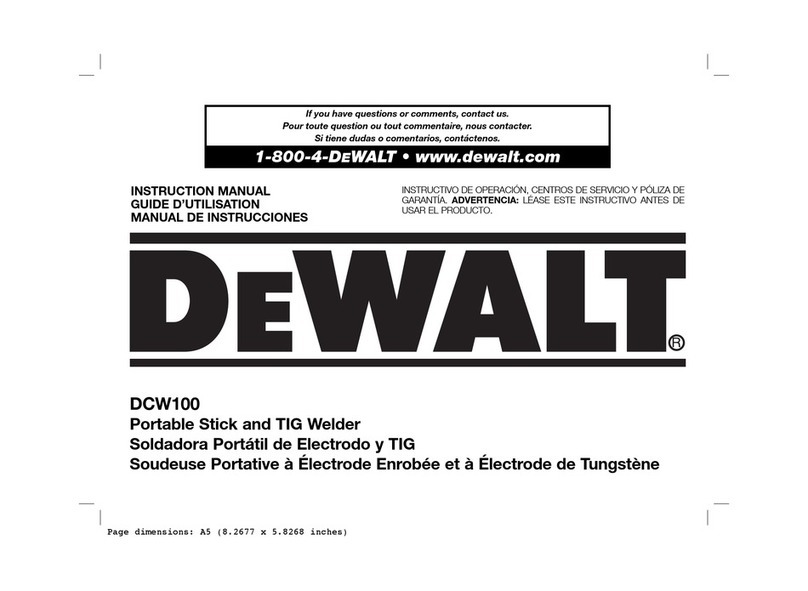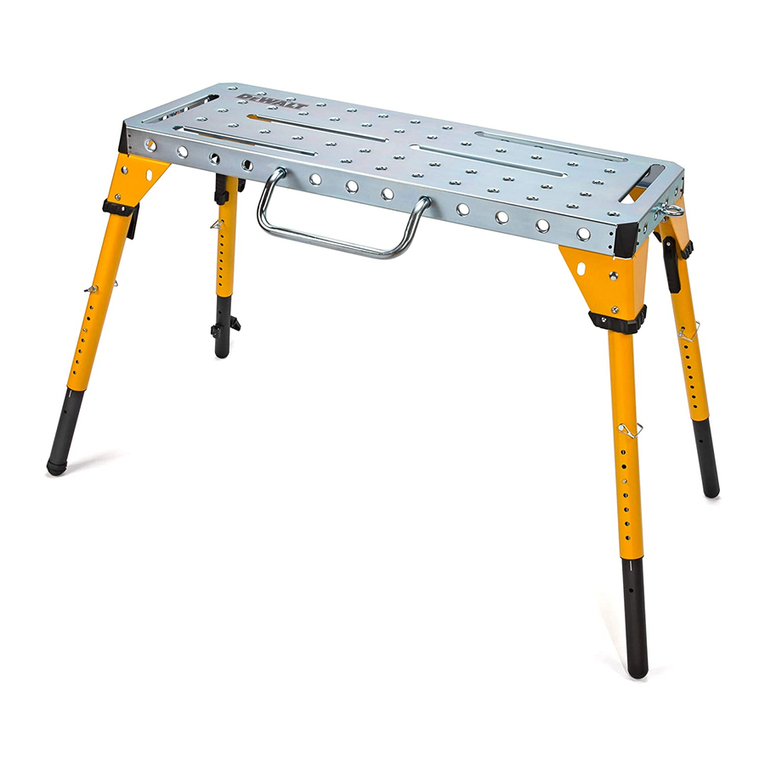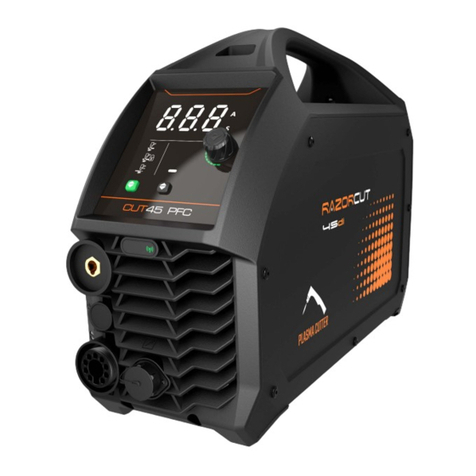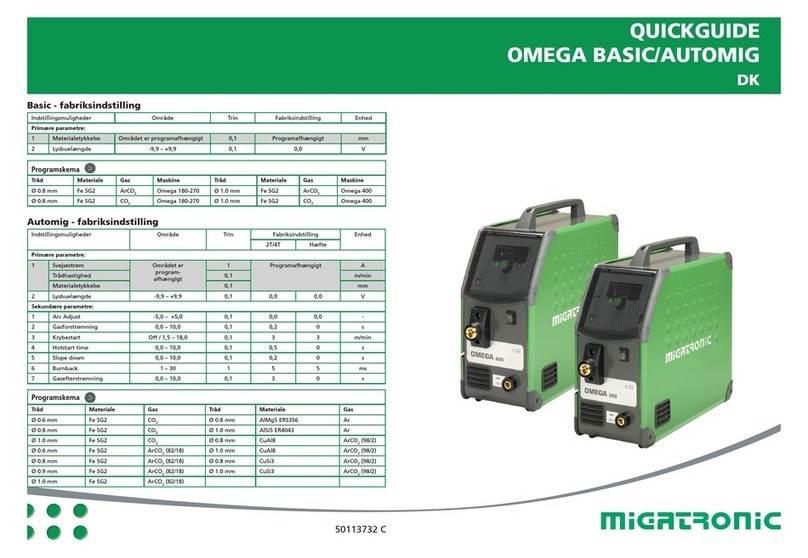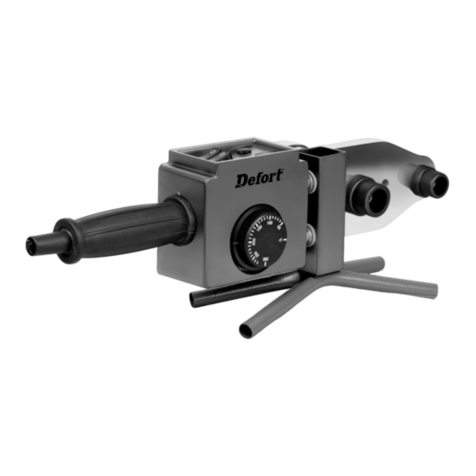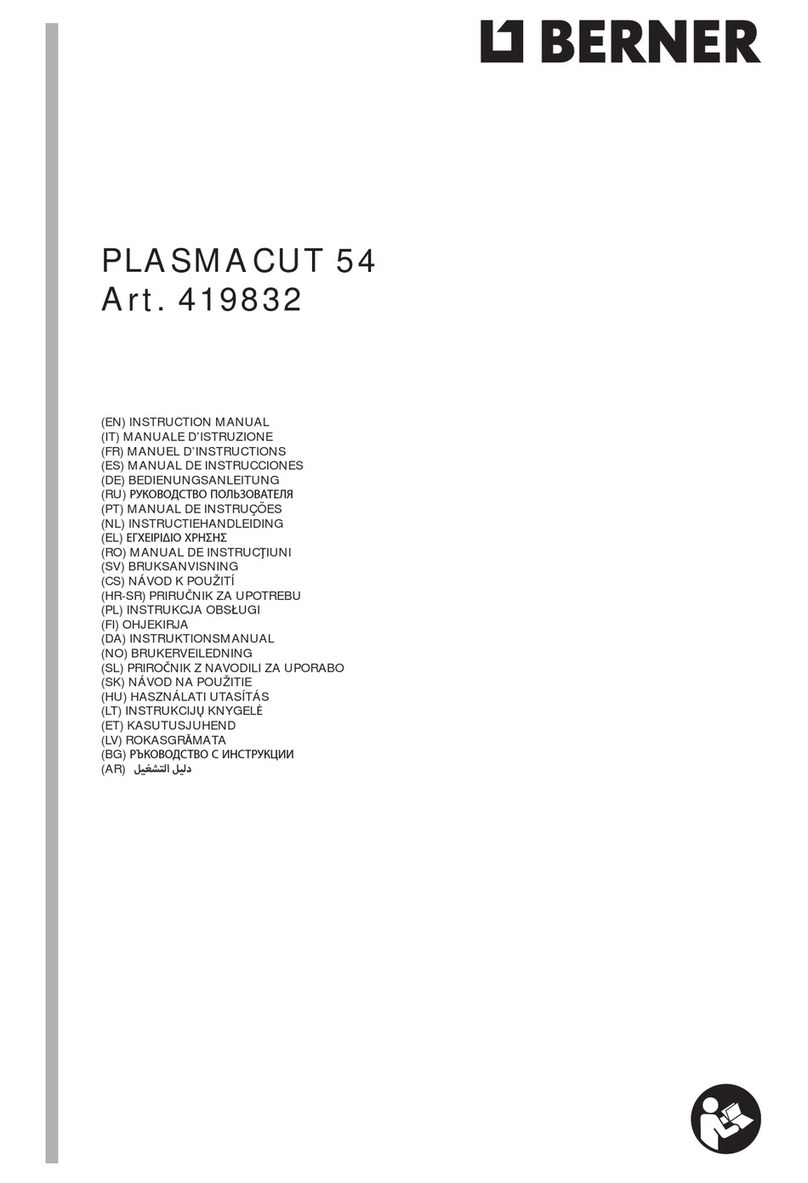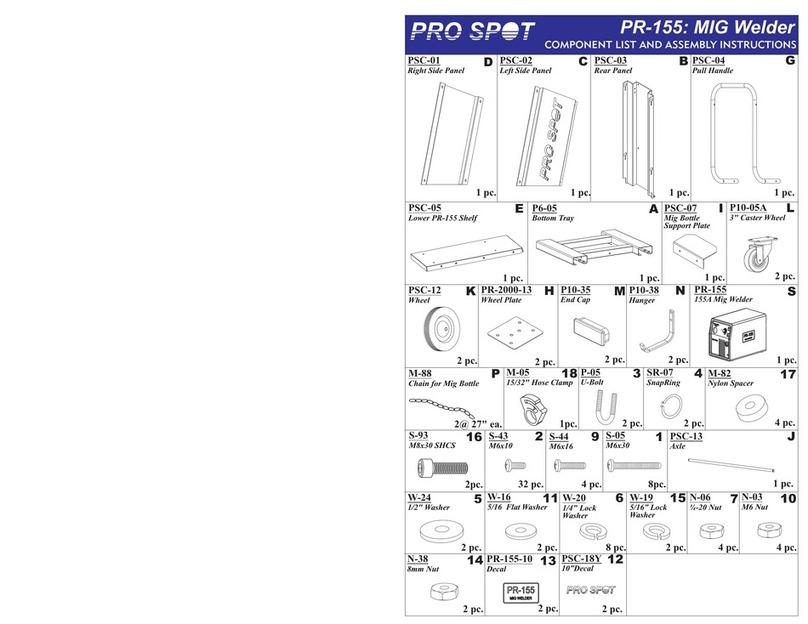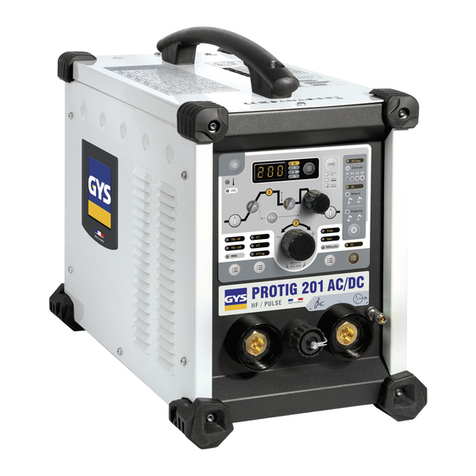DeWalt DCW100K User manual

Page dimensions: A5 (8.2677 x 5.8268 inches)
DCW100
Portable Stick and TIG Welder
Soldadora Portátil de Electrodo y TIG
Soudeuse Portative à Électrode Enrobée et à Électrode de Tungstène
INSTRUCTION MANUAL
GUIDE D’UTILISATION
MANUAL DE INSTRUCCIONES
INSTRUCTIVO DE OPERACIÓN, CENTROS DE SERVICIO Y PÓLIZA DE
GARANTÍA. ADVERTENCIA: LÉASE ESTE INSTRUCTIVO ANTES DE
USAR EL PRODUCTO.
If you have questions or comments, contact us.
Pour toute question ou tout commentaire, nous contacter.
Si tiene dudas o comentarios, contáctenos.
1-800-4-DEWALT • www.dewalt.com

Page dimensions: A5 (8.2677 x 5.8268 inches)

3
English
Definitions: Safety Guidelines
The definitions below describe the level of severity for each
signal word. Please read the manual and pay attention to
these symbols.
DANGER: Indicates an imminently hazardous situation
which, if not avoided, will result in death or seriousinjury.
WARNING: Indicates a potentially hazardous
situation which, if not avoided, could result in death or
seriousinjury.
CAUTION: Indicates a potentially hazardous
situation which, if not avoided, may result in minor or
moderateinjury.
NOTICE: Indicates a practice not related to
personal injury which, if not avoided, may result in
propertydamage.
IF YOU HAVE ANY QUESTIONS OR COMMENTS ABOUT
THIS OR ANY DEWALT TOOL, CALL US TOLL FREE AT:
1-800-4-DEWALT (1-800-433-9258).
FOR ALL SERVICE/REPAIR QUESTIONS ON THE WELDER,
CALL 1-800-4-DEWALT (1-800-433-9258). IF PRODUCT
NEEDS TO BE RETURNED FOR SERVICE, THE DEWALT CALL
CENTER WILL PROVIDE PACKAGING FOR SHIPPING.
Important Safety Instructions
Important Safety Instructions
WARNING: Do not operate this unit until you have carefully read
and understand this instruction manual for safety rules, workplace
preparation, assembly, operation and maintenance instructions.
WARNING: To reduce the risk of injury, read
the instructionmanual.
SAVE ALL WARNINGS AND INSTRUCTIONS
FOR FUTURE REFERENCE
Safety Rules and Warnings for Portable
Welders
• ALWAYS wear regulation protective gear and clothing.
Protective visor, regulation filter, ear protection, goggles with
side protection, insulated gloves and insulated footwear
should be worn when welding.
DANGER: Heat, flying sparks, pieces of hot metal and arc
radiation can damage skin and eyes.
• ALWAYS wear protective helmet to protect eyes
and face from UV rays, heat and sparks.
• Wear regulation protective goggles with side
protection and filter behind the protective visor.
• Wear correct eye, ear and body protection.
DANGER: Fumes produced during welding contain
harmful gases and vapors and must not be breathed
in. Welding fumes contain substances that may, under certain
circumstances, cause birth defects or cancer.
• NEVER use welder in poorly ventilated or
enclosed areas. Fumes produced during welding
contain harmful gases and vapors can build up in
these areas.
• Fumes and hazardous gases must be extracted
from the work area using appropriate methods.
If there is any doubt that extraction method is
adequate, the measured toxic emission values
must be compared to the permissible limit values.
• Ventilate the work area to ensure an adequate
supply of fresh air. Otherwise, a protective mask
with an air supply must be worn.
• Read all the relevant material safety data sheets
and manufacturer's specifications for the listed
components. Metals used for the workpiece,
electrodes, coatings, cleaners, etc. can be
responsible, amongst other things, for the degree
of toxicity of welding fumes.

Page dimensions: A5 (8.2677 x 5.8268 inches)
4
English
DANGER: Flying sparks and hot pieces of metal may burn
operator, cause clothing to catch fire or cause explosions.
• ALWAYS wear protective equipment and proper
clothing. Do not wear clothing with cuffs or turn-
ups that sparks could get into.
• Never weld near flammable materials. Flammable
materials must be at least 36 feet away from the
arc or properly protected by an approved cover.
• NEVER perform welding on containers that
were used to store combustible materials (e.g.
gases, propellants, oils). Material residues pose
an exploding hazard.
• NEVER perform welding near areas subject to
fire or near sealed tanks, vessels or pipes.
• A suitable, tested fire extinguisher must be nearby
and ready for use when welding.
DANGER: Failed or damaged parts can explode or cause
other parts to explode when power is applied.
• Never expose the device to naked flames or
permanent heat source. Excessive heat can
cause the battery to explode or burst.
• ALWAYS wear welding helmet and long sleeves
when servicing the unit.
DANGER: Electric current flowing through any conductor
causes localized Electric and Magnetic Fields (EMF).
Electromagnetic fields may pose as yet unknown risks to health.
• Wearers of pacemakers must seek medical advice
before coming near the device or any welding
operation in progress.
• For safety reasons, keep distances between the
welding cables and the welder's head/torso as
large as possible.
• Do not carry welder cables and hoses over the
shoulders or wrap around any part of thebody.
DANGER: Noise generated from welding can be damaging
to eardrums and contribute to hearing loss.
• Always wear proper personal hearing
protection that conforms to ANSI S12.6
(S3.19) during use. Under some conditions
and duration of use, noise from this product
may contribute to hearing loss.
DANGER: Welding comes with the risk of electricution
from the mains connection and/or welding current.
• NEVER touch live parts inside or outside of the
the unit.
• Keep all panels and covers securely in place and
disconnect power before servicing.
• ALWAYS wear suitable gloves (electrically
insulated and providing protection against heat).
• ALWAYS ensure operator and others nearby are
adequately protected and insulate from the work
and ground.
• All cables and leads must be secure and insulated.
Loose, scorched, or otherwise damaged cables
must be repaired/replaced immediately.
• The electrode must never be immersed in liquid
for cooling or touched when the power source is
switched on.
DANGER: Electric shock can kill; significant DC voltage
exists after the removal of input power.
• ALWAYS wait 60 seconds after power is turned
off before working on the unit.
• Check input capacitor voltage and be sure it is
near 0 before touching any part of the welder.

5
English
CAUTION: Stipulated environmental temperatures must be
maintained during transport, storage or operation of the charger
or else damage could result. The manufacturer shall not be held
liable for any damage arising from such usage.
• Do not store or use the welder in locations
where the temperature may exceed 105°F
(40 °C) or go below 14° F (40 °C) (such as
outside sheds or metal buildings in summer).
For best battery life store in a cool, dry location.
• When storing or transporting the device, be
sure the environment is not cooler than 68˚
F (20˚ C) or hotter than 131 °F (55 °C), the
welder is fully charged before storage and
is fully recharged every 6 months.
• Do not charge or use the welder in explosive
atmospheres, such as in the presence of
flammable liquids, gases ordust.
• The welder and charger should not be used be
used at altitudes exceeding 2000 m (6561 ft. 8.16
in.)
CAUTION: Devices with a higher rating may affect the energy
quality of the mains due to their current input.
• The operator should check whether the device may
be connected, where appropriate by discussing
the matter with the power supply company.
• NOTE: Ensure that the mains connection is
earthed properly
•Keep all persons, especially children, out of the working
area while any devices are in operation or welding is
inprogress.
•Never use the device for thawing out pipes, charging
batteries or starting engines.
Important Safety Instructions for
Welder Battery
The welder battery is not fully charged out of the carton. Before
using the welder, read the safety instructions below and then
follow charging procedures outlined.
WARNING: Improper handling of rechargeable batteries
can cause injuries or damage. This device uses a lithium-ion
batterypack.
• This manual contains important safety and operating
instructions for battery charger model DCWB009.
• Before using battery charger, read all instructions and
cautionary markings on battery charger, battery, and product
using battery.
CAUTION: To reduce risk of injury, charge only lithium-ion
type rechargeable batteries. Other types of batteries may burst
causing personal injury and damage.
• Do not open the device or remove the battery. If
the battery becomes damaged due to improper handling,
poisonous substances can escape which may be harmful
tohealth.
• Place the device on a solid, level surface so that it
remains stable. A toppling device can cause life-threatening
injuries. Do not allow the device to tilt past an angle 10˚.
• Do not use the handle strap to secure or hang the
welder or as a tether.
WARNING: Fire hazard. Never attempt to open the welder for
any reason. If the welder battery is cracked or damaged, do not
use the welder.
• DO NOT splash or immerse in water or other liquids. This can
cause a short circuit, even if the device is switched off. This in
turn can cause the battery to become hot, ignite or burst.
• Charge the battery packs only with the designated DEWALT
DCWB009 charger.
This manual suits for next models
1
Table of contents
Other DeWalt Welding System manuals
Popular Welding System manuals by other brands

Hobart Welding Products
Hobart Welding Products AirForce 375 owner's manual
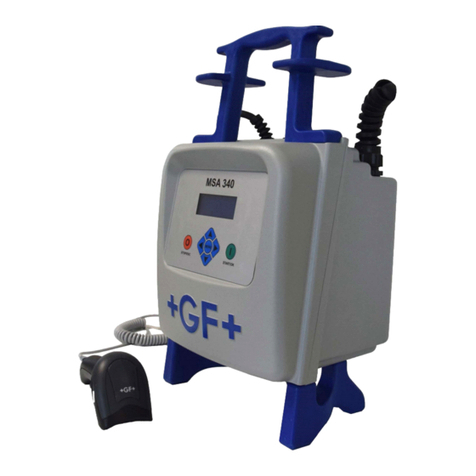
GF
GF MSA 330 instruction manual

Hakko Electronics
Hakko Electronics FX-888D instruction manual
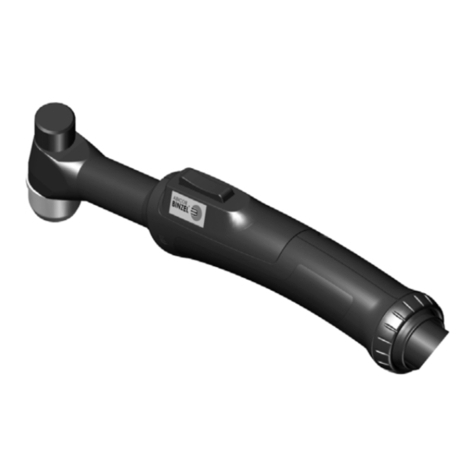
Abicor Binzel
Abicor Binzel ABIPLAS WELD 100 W operating instructions
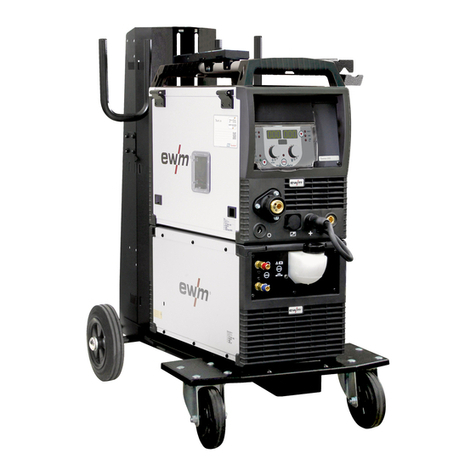
EWM
EWM Taurus 355 Basic TDM operating instructions
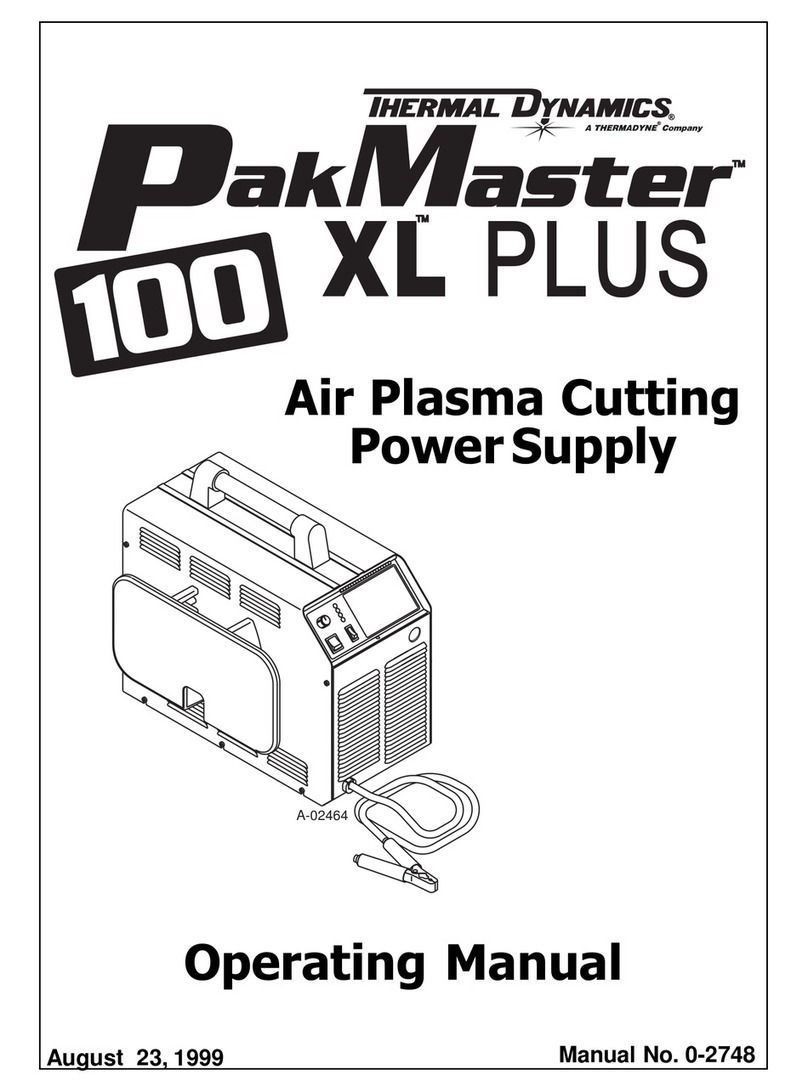
Thermal Dynamics
Thermal Dynamics PakMaster 100 XL plus operating manual
